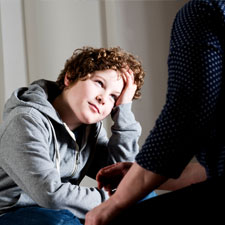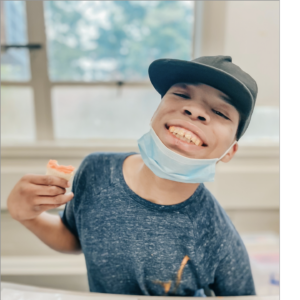Mental Well-Being Starts Young
Contributed by Jillian Szczepaniak-Gillece, Director of Behavioral Health Services, The Children’s Guild
 Young people in our country have real mental health issues today, and it was a serious problem before the pandemic, virtual school, and recent world conflicts.
Young people in our country have real mental health issues today, and it was a serious problem before the pandemic, virtual school, and recent world conflicts.
“Mental health challenges in children, adolescents, and young adults are real and widespread,” said Surgeon General Vivek Murthy. “Even before the pandemic, an alarming number of young people struggled with feelings of helplessness, depression, and thoughts of suicide—and rates have increased over the past decade.”
NUMBERS TELL A STARK STORY:
- In 2019, mental health challenges were the leading cause of disability and poor life outcomes in young people, with 1 in 5 children ages 3 to 17 in the U.S. having a mental, emotional, developmental, or behavioral disorder.
- From 2009 to 2019, high school students who reported persistent feelings of sadness or hopelessness increased by 40%, to more than 1 in 3 students.
- Suicidal behaviors among high school students increased during the last decade, with 19% seriously considering attempting suicide, a 36% increase from 2009 to 2019, and about 16% having made a suicide plan in the prior year, a 44% increase from 2009 to 2019.
- Between 2007 and 2018, suicide rates among ages 10-24 increased by 57%.
(Source: US Department of Health & Human Services)
It bears repeating—this was before recent events. In fall 2021, the American Academy of Pediatrics, the American Academy of Child and Adolescent Psychiatry and the Children’s Hospital Association joined to declare a National State of Emergency in Children’s Mental Health.
But how do you go about meeting the problems and working toward solutions? The Surgeon General’s Advisory on Protecting Youth Mental Health outlines a series of recommendations and they rely heavily on empowering youth and families, ensuring access to mental health care, supporting education, community and childcare settings, and expanding the early childhood and education workforce.
ON THE FRONT LINES WITH KIDS
“We are completely in support of the Surgeon General’s goals, as they align with our priorities, as well,” said The Children’s Guild President and CEO Jenny Livelli.
It’s critical to have services available to meet kids where they are, whether a clinic- or school-based program. The Children’s Guild operates seven schools in Maryland and the District of Columbia that all provide free mental health services to students. An Outpatient Mental Health Clinic serves more than 80 additional public schools across Maryland. Clinicians specialize in working with children and families and are trained in trauma-informed treatment.
“By being right in the school for kids, we are reducing barriers to access,” says Jillian Szczepaniak-Gillece, Children’s Guild Director of Behavioral Health Services. “We want to help each young person and their family learn skills to address interpersonal, social, emotional, and academic challenges. We work with caregivers, families, school staff, and other involved agencies to provide individualized treatment that is strength-based, trauma-informed, and evidence-based.”
MEETING THE NEEDS OF CHILDREN, FAMILIES, AND COMMUNITIES
One key to improving mental health is making support accessible. So, The Children’s Guild services include psychiatric services, counseling, and school-based behavioral health. More than 1,400 children are positively impacted by their programs and services today.
Mental health conditions can be shaped by many factors. Genes and brain chemistry play a role. So does environment, such as life experiences and neighborhood conditions. Relationships with family and friends are important. There are also many social forces. Young people see messages daily through social media and popular culture that erode their feelings of self-worth. To face these challenges and others, The Children’s Guild offers a continuum of care founded in Transformation Education.
A PIONEERING FORCE IN EDUCATION
Transformation Education engages every student, fosters achievement, growth, and independence to the greatest extent possible, and gives experiences that meet the needs of every learner and help them thrive.
The 8 Pillars of The Children’s Guild Transformation Education philosophy include:
- Value-Infused Culture – blending specific values throughout all aspects of our people, systems, environment, and curriculum.
- Focus on Well-Being – mindfulness exercise, positive relationships with adults, and the development of self-regulation strategies.
- Enriched Environments & Experiences – using physical environments to stimulate the intellect, excite the senses, and touch the emotions.
- Brain Literacy – teaching students how the brain learns.
- Behavioral Motivation Continuum – individualized, meaningful learning experiences before, during, and after behavioral incidents to help kids develop self-regulation.
- Arts Enhancement – opportunities to experience performing arts, visual arts, and music.
- Community Influence – introducing kids to community projects and advocacy so they can contribute their voice.
- Ownership Mindset – skills to approach problems, recognize contributions, take responsibility, and implement solutions.
ORGANIZATIONS LIKE THE CHILDREN’S GUILD ARE MORE IMPORTANT THAN EVER
Emerging from April’s School Counseling Month—as well as the past two years of COVID—it’s apparent the national focus on mental health is even more critical. “We need to build the foundation for healthier, more fulfilled, and more resilient youth, and The Children’s Guild is making that happen in the greater metro area around the Nation’s Capital,” said Livelli.
“We touch families and lives in meaningful, often highly impactful ways. That commitment has become even more critical in our complex world.”
The Children’s Guild also seeks partnerships and growth opportunities of all kinds. Should you want to learn more or see the work they do in area schools, please contact them anytime at 410.444.3800.
 Over the past six months, the Children’s Guild— Transformation Academy has become a thriving environment for dozens of students ages 5-21 whose primary diagnosis is autism, and many who have co-existing diagnoses of sensory processing disorder, a specific learning disability, health impairment or multiple disabilities. During the month of April, which is officially Autism Awareness Month, The Children’s Guild— Transformation Academy will highlight the integrated approach they take in educating and providing individualized instruction in the areas of academics, behavior, social skills, and life skills to meet the needs of neurodiverse individuals.
Over the past six months, the Children’s Guild— Transformation Academy has become a thriving environment for dozens of students ages 5-21 whose primary diagnosis is autism, and many who have co-existing diagnoses of sensory processing disorder, a specific learning disability, health impairment or multiple disabilities. During the month of April, which is officially Autism Awareness Month, The Children’s Guild— Transformation Academy will highlight the integrated approach they take in educating and providing individualized instruction in the areas of academics, behavior, social skills, and life skills to meet the needs of neurodiverse individuals.







